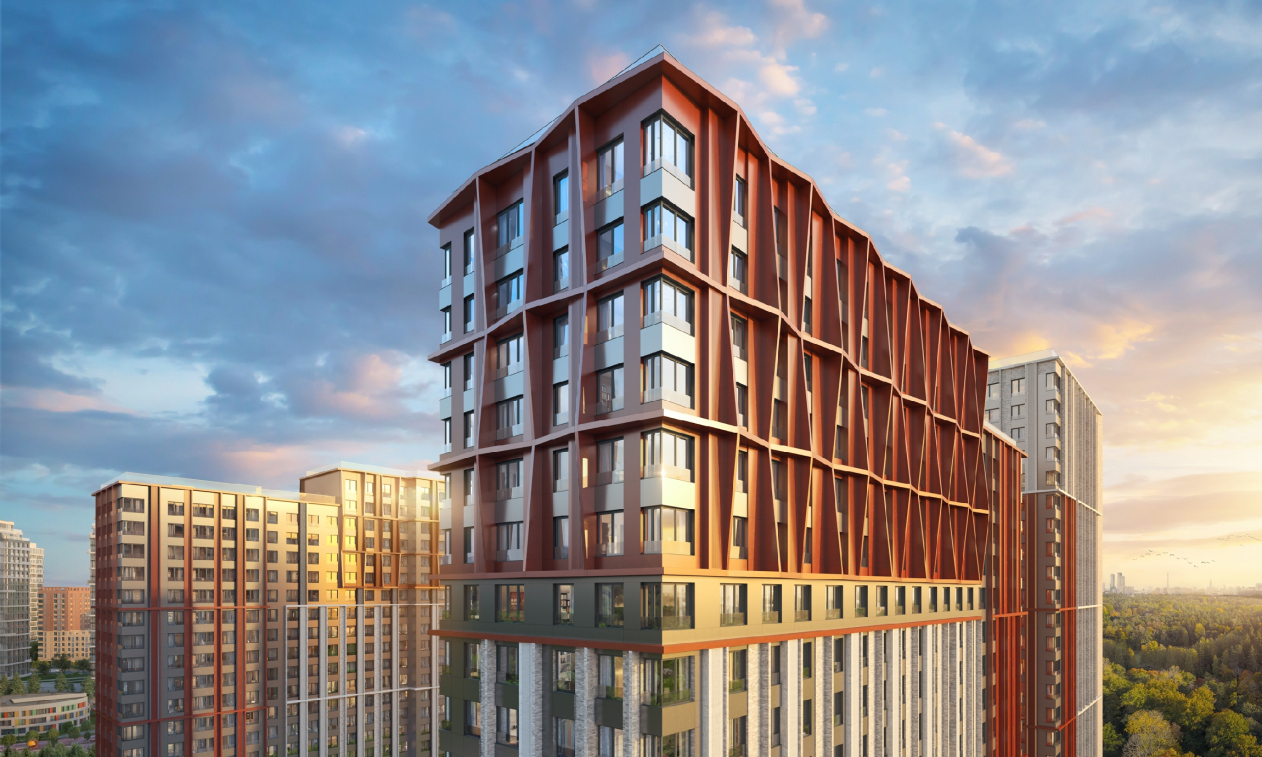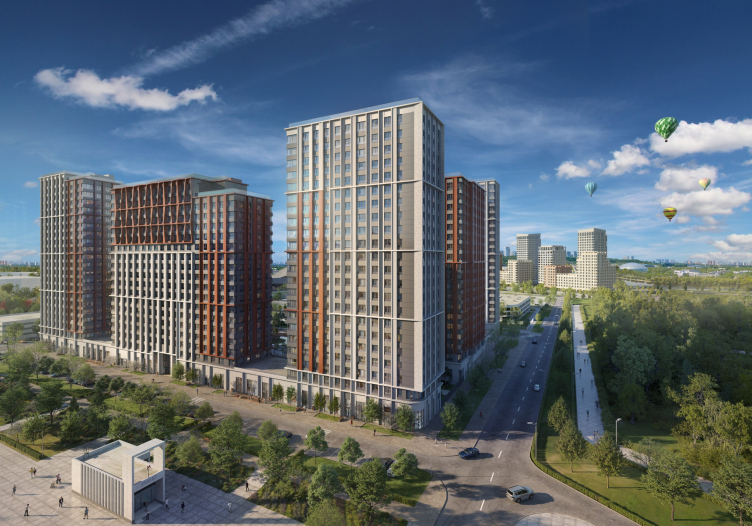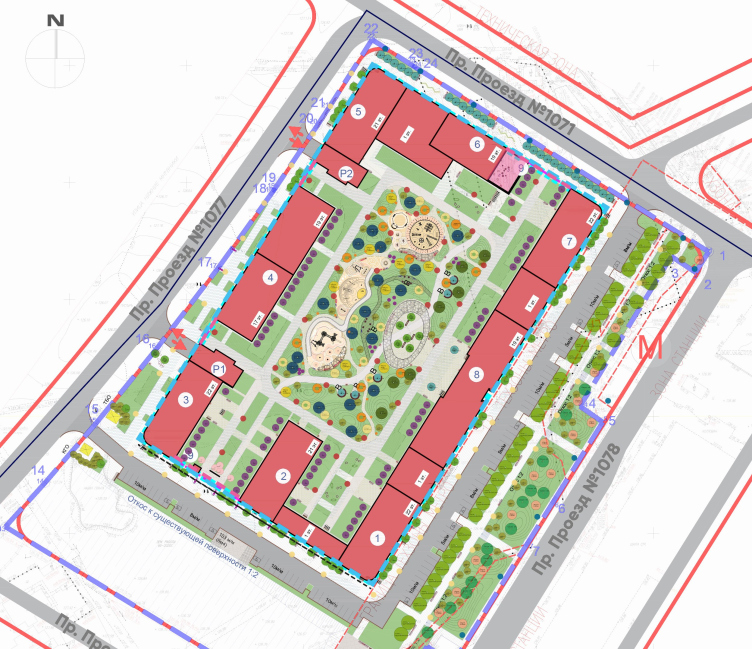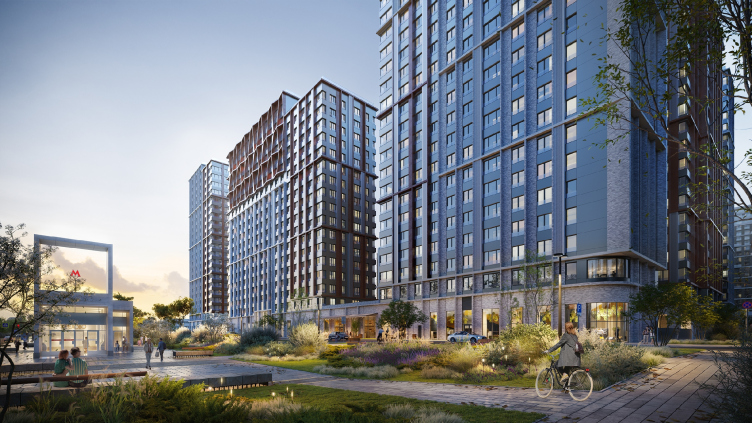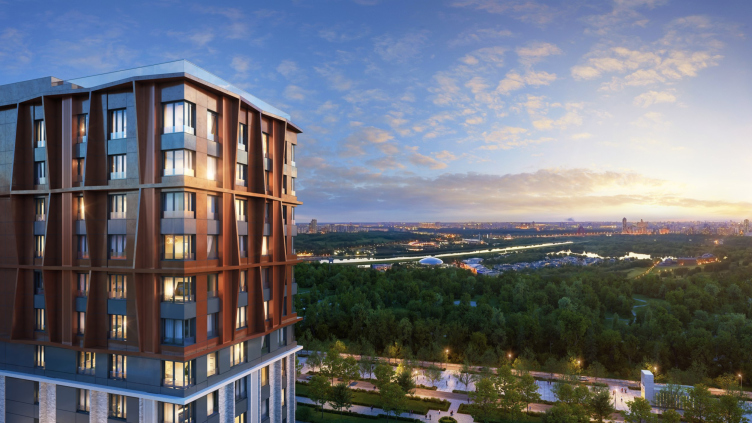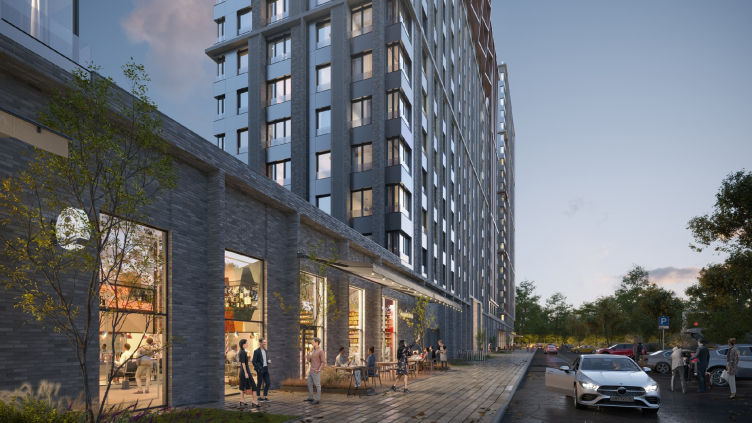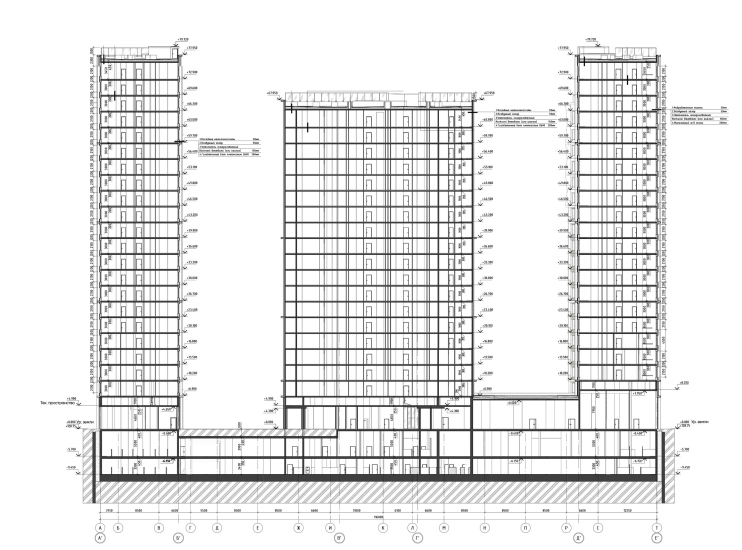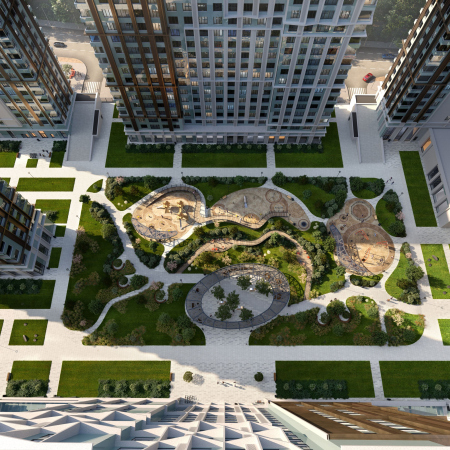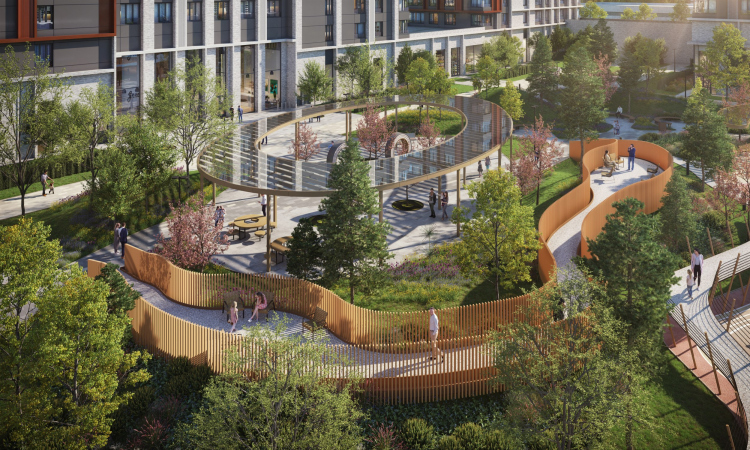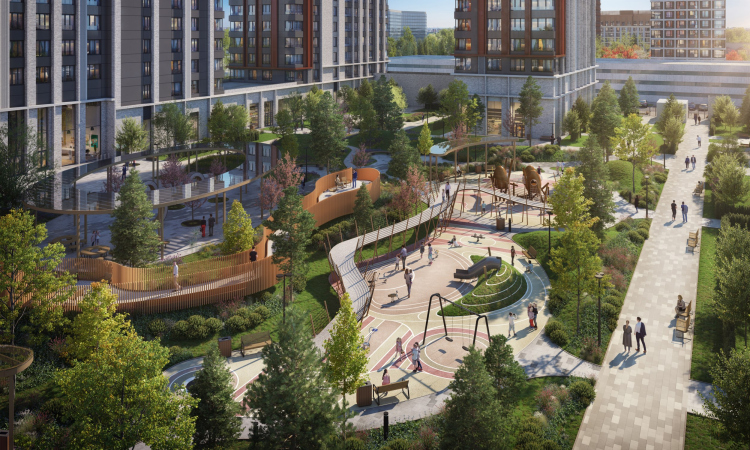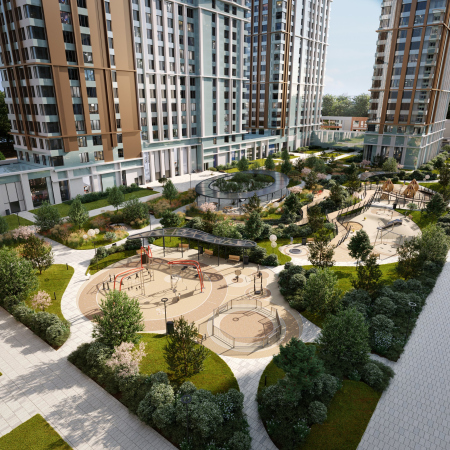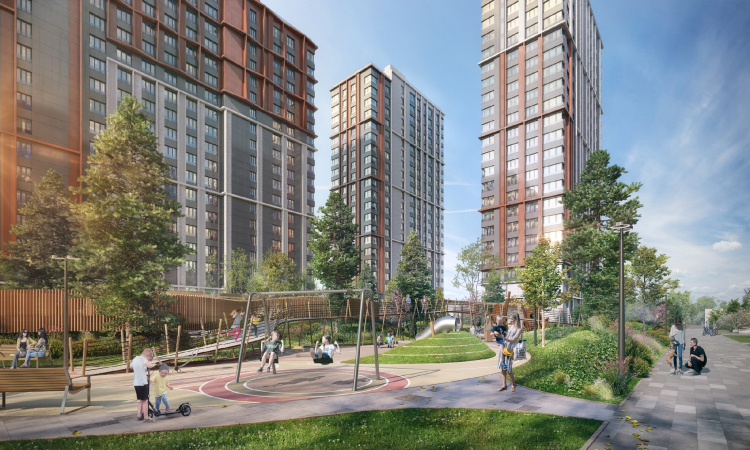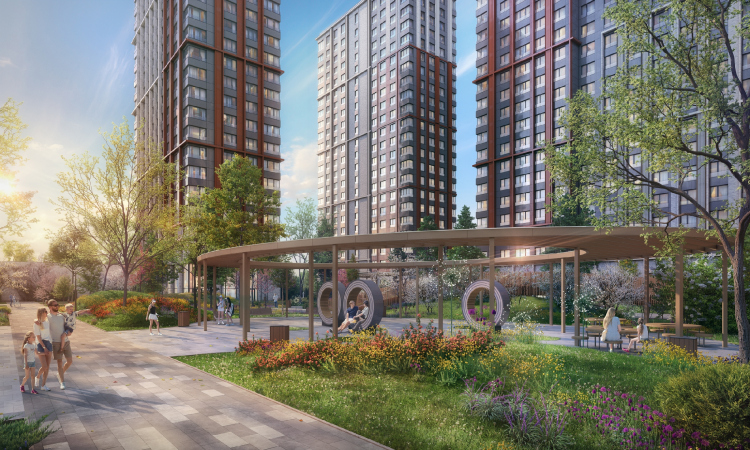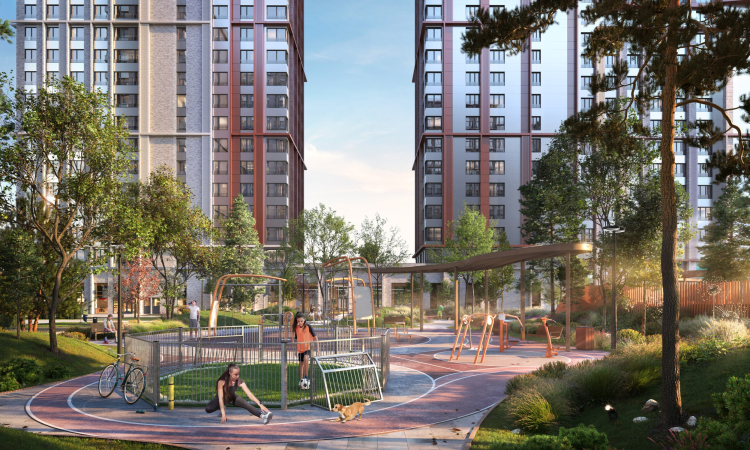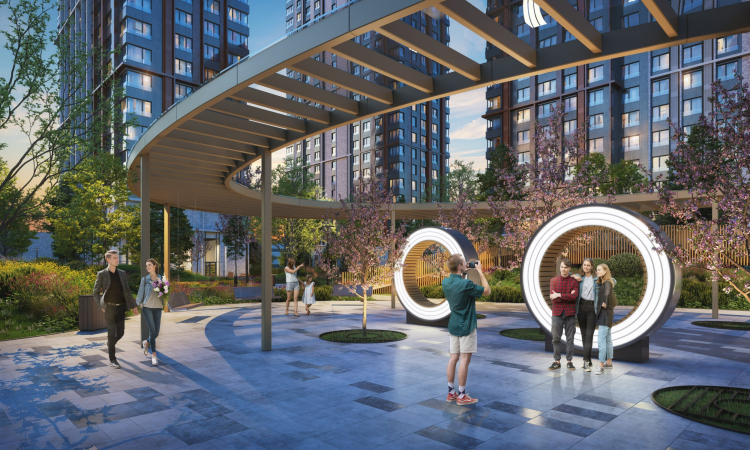Ostrov housing complex
Copyright: © UNK
Due to the fact that Ostrov was designed in a “clear field”, it was possible to build links between Block 5 and Block 6. They are built along the northern border of a wide boulevard, the main artery of the complex, under which the subway line runs. Between themselves, the blocks are separated by a passage transverse to the boulevard – at their intersection, there will be the main square, or rather its main part, with a media cubicle. This is where most of the pedestrians will walk, if only because people get off the subway here.
Ostrov housing complex, Block 5
Copyright: © ASADOV architects / provided by UNK
This way, the architects of Block 6, UNK, and Block 5, ASADOV, agreeing this solution between themselves, built on either side of the transverse passage three towers each, vis-a-vis, they salute to one another, effectively creating a grand-scale town-planning symmetry in the way of Manhattan. Between these two blocks, there will be a rectangular shopping mall, standing with its side end towards the media cube: it was part of the agenda of Block 5, and it was Alexander Asadov that proposed to position it in this specific way – Julius Borisov shares.
Ostrov housing complex, Block 5
Copyright: © ASADOV architects
Block 5 was designed by ASADOV Architects in collaboration with UNK, which curated the entire process of designing Blocks 3-6, including the landscaping and lighting parts.
We were excited to take on this project because it was very timely for us. We worked together with our colleagues from UNK, we met with them, discussing things, and we did everything within the framework of the design code proposed by them. The rather high density of the required development determined the composition of the towers that flank the rectangular plot with regular breaks; in the lower part they are all connected by a stylobate.
We emphasized copper facades with relief texture of the partitions – so that our block echoes Block 6 of UNK not only in terms of the composition of the ensemble, but also in its material. Our copper attics “salute” the corner tower designed by our colleagues.
We emphasized copper facades with relief texture of the partitions – so that our block echoes Block 6 of UNK not only in terms of the composition of the ensemble, but also in its material. Our copper attics “salute” the corner tower designed by our colleagues.
So, the background material of the facades is metal and brick, both in light and dark gray shades, and the main theme is the connection of floors vertically in groups of 5-6 each, a technique that disciplines vertical proportions and is widespread in Moscow in recent years. The variegated grid is duplicated by the relief of thin projecting ribs, they frame the spots and reinforce the verticals. On the courtyard side, the latitude-oriented houses receive symmetrical projections of very small outreach, which further strengthens the verticals, adds classicism and creates hidden echoes with the club house of Block 3.
Ostrov housing complex, Block 5
Copyright: © ASADOV architects / provided by UNK
The copper-colored metal forms both vertical stripes and large spots, and sometimes, in smaller towers, entire facades are given over to it – there is more copper here than in any other block of the Ostrov. But the most noticeable copper volume is, of course, the attic of the middle tower facing the boulevard – it serves as an identifying accent of the whole block. The six floors form the likeness of a shining “head” on the Academy of Sciences, only larger and situated closer to the viewer. The surface is delineated with a volumetric zigzag, also popular in Moscow in recent years. In this case the difference is that it is not the whole partitions that “sway”, but just the thin ribs; the rest of the copper walls form a background enlivened by the relief of thin strips. The same solution is mirrored in another house of the block, on the northern side.
Ostrov housing complex, Block 5
Copyright: © ASADOV architects / provided by UNK
Ostrov housing complex, Block 5
Copyright: © ASADOV architects / provided by UNK
The relation of the houses to the space of the complex is twofold and is also conditioned by the general design code. From the outside, the stylobate, which unites the towers, builds a level front of the city streets: as we remember, a large pedestrian traffic and a boulevard are planned here. This means storefronts, cafes, restaurants, and light streaming from large panes of glass. Thin ribs here, at the pedestrian level, create a colonnade – an echo of the volumetric pedestrian galleries that are present in Blocks 3 and 6.
Ostrov housing complex, Block 5
Copyright: © ASADOV architects / provided by UNK
The residential sections and stylobate lintels form a largely closed contour around the courtyard, providing the privacy so valued in modern new buildings. Along the boulevard, stretches a continuous front of rental space, i.e. cafes and stores. In less stressful places, at the ends of the rectangular plot and on the northwest side, where a school is being built in the neighboring second block, the contour is interrupted, revealing entrances and exits from the courtyard. A fitness center is built into the first floor of one of the northern sections.
The landscaping of the courtyard was designed by the Scape bureau and also echoes the main principles of the complex: while both the houses themselves and the external space around them are laid out in a “linear” urban way, then in the courtyard the authors are looking for the natural fluidity typical of parks and, on the other hand, catch the general theme of Ostrov’s landscaping. So the paths are flexible, geoplastic is also present, the awnings look like dragonfly wings, while the pergolas and sculptural installations, firstly, are ring-shaped, which plays off the symbolism of the complex associated with the bagel, and secondly, they shine with media facades. Both of them guarantee a change of impressions for the residents and their guests when moving from the outer space to the inner one.
To summarize, we can say that the block designed by ASADOV is a vivid example of good teamwork. It is with its help that a well-coordinated town-planning ensemble is formed in the center of Ostrov; it takes a significant share of residential areas, it is comprehensively rhymed with the neighboring blocks – and at the same time its accents do not draw absolutely all the attention, in terms of plastique expression it is rather delicate and is distinguished by the ability to build a dialogue without “outshouting” the environment – an important advantage when designing large new districts by different teams of architects.

